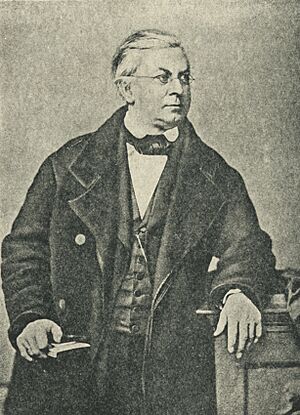Karl Theodor Ernst von Siebold facts for kids
Karl Theodor Ernst von Siebold (born February 16, 1804 – died April 7, 1885) was an important German physiologist and zoologist. He helped to define and introduce new groups of animals, like Arthropoda and Rhizopoda. He also clearly described Protozoa as a group specifically for tiny, single-celled organisms.
Contents
About Karl von Siebold
Karl von Siebold was born in Würzburg, a city in what was then Bavaria. His father, Elias von Siebold, was a professor who taught about childbirth. Karl studied medicine and science, mainly at the University of Berlin. He also studied at Göttingen.
In 1831, he started working as a doctor in Heilsberg. Later, in 1834, he moved to Königsberg and then to Danzig. In Danzig, he became the director of a school for midwives.
He became a professor of zoology (the study of animals) in 1840 at Erlangen. After that, he taught in Freiburg, Breslau, and finally in Munich. In Munich, he also became the director of the zoological collection.
Karl von Siebold was recognized for his work by many important groups. He became a member of the Royal Swedish Academy of Sciences in 1856. He was also elected to the American Philosophical Society in 1869.
He passed away in Munich in 1885. People remembered him as a very hardworking and careful scientist. Many called him the "Nestor of German zoology," meaning he was a wise and respected leader in the field.
His Scientific Discoveries
Karl von Siebold made many important contributions to science. His most famous book was Lehrbuch der Vergleichenden Anatomie (Manual of Comparative Anatomy). He wrote the first part of this book, which focused on invertebrates (animals without backbones).
He was one of the first scientists after Georges Cuvier to make big changes in how animals were classified. He showed that Protozoa are made of just one cell and grouped them together into a major category called a phylum. He also introduced the names for two important animal groups: Arthropoda (like insects and spiders) and Rhizopoda (a type of protozoa).
In 1848, he started a leading biology magazine called Zeitschrift für Wissenschaftliche Zoologie (Journal for Scientific Zoology). He edited this magazine until he died. It became a very important journal for studying animal structure and anatomy in Europe.
Important Research
Siebold's scientific achievements included several key discoveries:
- In 1851, he helped describe the blood-fluke Schistosoma haematobium for the first time. This is a type of parasite.
- In 1853, he explained the full life cycle of the tapeworm Echinococcus granulosus.
- In 1854, he suggested how the fluke Fasciola hepatica (a type of flatworm) infects animals. He figured out that a certain stage of the fluke passes from one host to another.
- In 1856, he discovered parthenogenesis in insects. Parthenogenesis is a special way some animals can reproduce without a male. It means an egg can develop into a new individual without being fertilized.
He also studied other animals like jellyfish, different types of tapeworms, flukes, and strepsipterans (a type of insect).
His collection of worm specimens was bought by the Natural History Museum, London in 1851. His collection of freshwater fish from Bavaria was given to the Zoological Cabinet in Munich. Even though many were lost in World War II, some are still kept there today.
Family Life
Karl von Siebold was married twice. His first wife was Fanny Noldechen, who passed away in 1854. In 1855, he married her younger sister, Antoynie Noldechen.
His father was a cousin (some say a younger brother) of Philipp Franz von Siebold. Philipp was also a famous naturalist and doctor.
Key Books and Publications
Here are some of the important books and papers Karl von Siebold published:
- Observationes de Salamandris et Tritonibus (1828) - This was about salamanders and newts.
- Beiträge zur Naturgeschichte der wirbellosen Thiere (Contributions to the natural history of invertebrates; Danzig, 1839)
- Lehrbuch der vergleichenden Anatomie der Wirbellossen Thiere (Manual of comparative anatomy of invertebrates; Berlin, 1848) - This was a very important book about the anatomy of animals without backbones.
- Ueber die Band- und Blasenwürmer (1854) - About tapeworms and bladder worms.
- Wahre Parthenogenesis bei Schmetterlingen und Bienen (True parthenogenesis in moths and bees; 1856) - This book explained his discovery of parthenogenesis in insects.
- Die Süsswasserfische Mitteleuropas (Freshwater fish of Central Europe; Leipzig, 1863) - Here he described freshwater fish and even some hybrid forms.
- Beiträge zur Parthenogenesis der Arthropoden (Contributions on the parthenogenesis of Arthropods; 1871) - In this work, he showed that parthenogenesis happens in certain wasps, sawflies, moths, and crustaceans.
See also
 In Spanish: Karl Theodor Ernst von Siebold para niños
In Spanish: Karl Theodor Ernst von Siebold para niños
- Category:Taxa named by Karl Theodor Ernst von Siebold
Animals Named After Siebold
Several animals have been named in honor of Karl von Siebold, recognizing his contributions to zoology. Here are a few examples:
- Ergasilus sieboldi von Nordmann, 1832
- Lineola sieboldii (Kölliker, 1845) Gerlach & Riemann, 1974
- Pegantha sieboldi (Haeckel, 1879)
- Trichosphaerium sieboldi Schneider, 1878
- Stenostomum sieboldi von Graff, 1878
- Colobomatus sieboldi (Richiardi, 1877)
- Hyalonema sieboldi Gray, 1835
Also, two types of snakes are named after him:
- Geophis sieboldi Jan, 1862
- Amphiesma sieboldii (Günther, 1860)


